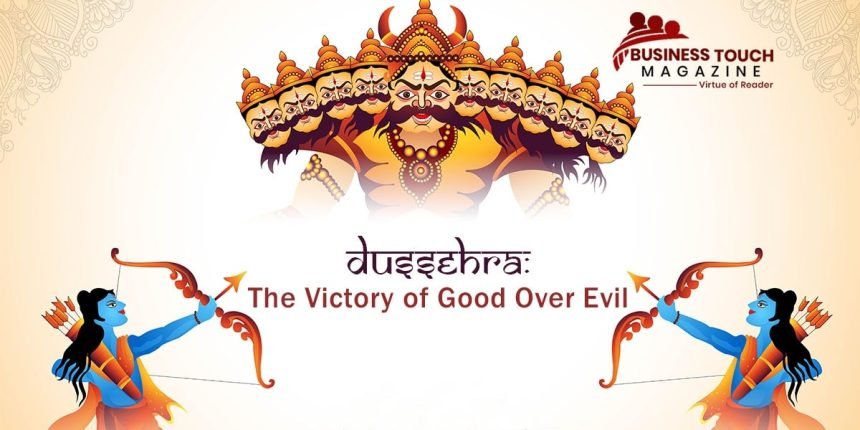Now is the most wonderful time of the year. The schedule is packed with festivals, and planning is well on for each one. Navratri is celebrated at the start of October, while Dussehra is celebrated towards the end of the month. One of Hinduism’s most significant celebrations is Dussehra. As a celebration of the triumph of good over evil, the event provides cause for celebration.
Why Do People Celebrate Dussehra?
Dussehra is celebrated in a wide variety of ways across India due to the country’s rich cultural diversity. Dussehra is celebrated in the eastern and southern states to commemorate the triumph of the goddess Durga over the demonic king Mahishasura. Navratri is a nine-day celebration that starts on the first day of the festival. However, the majority of India’s northern and western states commemorate Dussehra as Lord Rama’s triumph over Ravana.
King Dasharatha wished to make his oldest son Rama the next king of Ayodhya a very long time ago. Every citizen of the realm was relieved by the choice and excited for the upcoming coronation. Queen Kaikeyi, on the other hand, aspired for her son Bharata to rule Ayodhya. That’s why she’s claiming two boons from King Dashratha on the night of the wedding, even though they were bestowed to her years ago. She insists that Rama spend fourteen years in exile in the woods and wants Bharata to be anointed king of Ayodhya.
It seemed inevitable that King Dashratha would grant her these wishes. Thus, Rama, his wife Sita, and his brother Lakshmana were exiled from their homeland. For thirteen years, the royal couple forwent all royal comforts in favour of exploring the woods. A Rakshasi named Surpanakha attempts to seduce the two brothers during their last year in exile. After her attempt to murder Sita fails, she blames Sita for her failure. Lakshmana, however, intervenes and removes her ears and nose. Surpanakha returns to her brother Ravana, the terrible lord of Lanka, wounded and humiliated. Ravana is out for revenge after seeing his sister’s public disgrace, so he abducts Sita.
Sita is kidnapped by him and brought to his country, where he proposes to her. Since her devotion is with Rama, Sita emphatically declines. The king then takes her to the Ashoka grove to keep her as a hostage. Lord Rama and Lakshmana immediately went out to rescue Sita after hearing this news. They run across Lord Hanuman, an enthusiastic follower of Rama, along the journey. When Hanuman reaches Lanka, he locates Sita and gives her the good news that Lord Rama is on his way to bring her safety.
After Hanuman assures Rama that Sita is safe, the group continues on its way to Lanka. There’s going to be a great fight between Lord Rama’s army and Ravana’s. In an epic showdown with the ten-headed Ravana, he wipes out the majority of the Lankan army. A vicious struggle ensues between Lord Rama and Ravana, but in the end, Rama triumphs and is reunited with Sita. They return to Ayodhya once their exile is finished, and Lord Rama is anointed king.
How Do People Celebrate Dussehra?
Dussehra, also called Durga Puja, is celebrated on the tenth day of Navratri. Navaratri begins with the worship of Maa Shailaputri and continues with the devotion of Maa Chandraghanta, Maa Skandmata, and the other avatars of Goddess Durga. The Dussehra festival lasts for 10 days in the northern, western, and central regions of India. The Ramayana is the inspiration for many dance and theatre performances. RamLeela is a term used to describe these comedic performances, which are well-known all over the globe. Every detail of Ravana’s abduction of Maa Sita and Lord Rama’s courageous battle against the wicked monarch are shown in RamLeela. Dussehra, celebrated on the tenth day, commemorates Rama’s triumph over Ravana and his reunification with Sita.
Dussehra is celebrated quite differently in the eastern and southern regions of India. Additionally, it is one of the most looked forward to holidays in Hinduism, since Durga Puja is one of the most well-known celebrations of the Hindu goddess Durga. The tenth day, Durga Puja or Dussehra, is the most significant for believers. The previous nine days of Navratri are devoted to various manifestations of Goddess Durga. On this day, devotees immerse statues of Durga in rivers, seas, and other bodies of water to honour the goddess. After being submerged, Goddess Durga is said to visit Mount Kailash, where she is reunited with Lord Shiva. During the ritual of immersion, worshippers pray and sing songs to Goddess Durga in hopes of receiving her favour.
The Significance of Dussehra.
Devotees in the eastern states honour the nine incarnations of Goddess Durga on the nine days leading up to Dussehra, also known as Durga Puja. These nine guises reveal many facets of Durga, the Goddess. Maa Bramhacharini is revered for her association with tranquilly and holiness, whereas Maa Kushmanda is honoured as the cosmic powerhouse. Buying something brand new is another popular Dussehra tradition. It is a day of good fortune and is thus ideal for beginning anything new.
Devotees believe in commemorating this occasion with their close friends and family, and they do so by giving them presents and sweets. A common theme in prayers is the need for a clean slate and the desire for forgiveness. Celebrating Dussehra is a significant element of Indian tradition. Foreign visitors are drawn to the country in large part because to its vivid colours, giant icons, and universal themes. It is revered by believers and is often followed by Diwali, the Hindu Festival of Lights.




